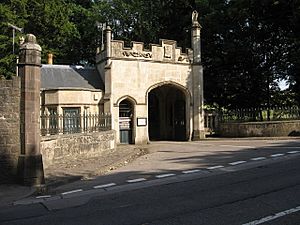Llantarnam Abbey facts for kids
Quick facts for kids Llantarnam Abbey |
|
|---|---|

"large, antiquated mansion … having … an appearance of gloom and decay"
|
|
| Type | House |
| Location | Llantarnam, Torfaen |
| Built | 16th and early 19th centuries |
| Architect | Thomas Henry Wyatt |
| Architectural style(s) | Tudor Revival architecture |
| Governing body | Privately owned |
|
Listed Building – Grade II*
|
|
| Official name: Llantarnam Abbey | |
| Designated | 6 June 1962 |
| Reference no. | 85246 |
|
Listed Building – Grade II
|
|
| Official name: Forecourt walls and gates at Llantarnam Abbey | |
| Designated | 6 June 1962 |
| Reference no. | 81867 |
|
Listed Building – Grade II
|
|
| Official name: Garden walls and gates at Llantarnam Abbey | |
| Designated | 6 June 1962 |
| Reference no. | 81868 |
|
Listed Building – Grade II
|
|
| Official name: Two statues in garden to the east of Llantarnam Abbey | |
| Designated | 30 September 2003 |
| Reference no. | 81874 |
|
Listed Building – Grade II
|
|
| Official name: The Monks Cell at Llantarnam Abbey | |
| Designated | 30 September 2003 |
| Reference no. | 81873 |
| Lua error in Module:Location_map at line 420: attempt to index field 'wikibase' (a nil value). | |
Llantarnam Abbey is a very old building in Llantarnam, near Cwmbran in southeast Wales. Today, it is home to the Sisters of St Joseph of Annecy, a group of nuns. Long ago, it was a Cistercian monastery where monks lived and worked. It is considered a very important historical site, recognized as a Grade II*-listed building.
Contents
History of the Abbey
Llantarnam Abbey was started as a 'daughter house' of another abbey called Strata Florida Abbey in Ceredigion. This means it was like a new branch or offshoot of the older monastery. It was founded in the late 1100s and was active for over 350 years.
From Monks to Family Home
In 1536, King Henry VIII closed down many monasteries in England and Wales. This event was called the Dissolution of the Monasteries. Llantarnam Abbey was one of them, closing its doors on August 27, 1536.
After the monks left, the abbey and its lands were sold to the Morgan family. William Morgan bought the property in 1554. He later became a Member of Parliament (MP), which means he was elected to help make laws for the country. He also served as High Sheriff, a local official.
His son, Edward Morgan, may have built the abbey as we know it today. Edward was also an MP and High Sheriff. He was often fined because he refused to follow the new official religion. His son, Sir Edward Morgan, 1st Baronet, was a strong supporter of the King during the English Civil War.
The second baronet, also named Edward, helped hide a Jesuit priest named Saint David Lewis. This priest was later executed in Usk in 1679.
New Owners and Changes
After the Morgan family, the house was not always lived in. Then, Reginald Blewitt took over. He rebuilt the abbey between 1834 and 1836 in a style called Tudor Revival. This style made the building look like old Tudor houses. The changes supposedly cost a lot of money, about £60,000. Because of this huge expense and other money problems, Blewitt had to leave the country for many years.
After Blewitt died, his nephew inherited the property. In 1895, he sold the abbey to Sir Clifford Cory. Sir Clifford was a wealthy man who owned coal mines and shipping businesses. He was also a Liberal politician. He lived at the abbey until he died in 1941.
World War II and Return to Monastic Life
During the Second World War, Llantarnam Abbey was used by the American Army as a supply depot. After the war, in 1946, it became a monastic institution again. The Sisters of St Joseph of Annecy moved in, and they still live there today.
The main abbey building was officially listed as a Grade II* building on June 6, 1962. This means it is a very important historical building.
Archaeological Discoveries
Archaeology is the study of human history through digging up old sites and artifacts. Llantarnam is listed as an important medieval site for archaeology in Wales.
Archaeologists have found evidence of a deserted village near the abbey. This village seems to have started in the 1200s and was abandoned by the 1700s. It might have been cleared to make space for the abbey's gardens.
Many archaeological digs have taken place around Llantarnam Abbey:
- In the 1980s, excavations were done before water storage lagoons were built.
- In the early 1990s, more work happened before a major road was constructed.
- Further studies were carried out in the late 1990s by different universities and archaeological groups.
These studies have helped us learn more about the history of the abbey and the people who lived around it. While many reports exist, a full published report combining all the findings is still needed.
- Mein AG 1982 A deserted village and other remains, Llantarnam Abbey, near Cwmbran, Gwent Anna Rep
- Glamorgan-Gwent Archaeol Trust 1981-2, 47-52
- GGAT 1990 A4042 Newport-Shrewsbury Trunk Road: Llantarnam Bypass DBA
- GGAT 1992 Llantarnam Village Fe
- GGAT 1993 Excavations At Llantarnam Village, Gwent Exc
- GGAT 1994 Abbey Farm Lands, Llantarnam Wb
- Birmingham University 1998 Abbey Farm, Llantarnam Wb
- Cambrian Archaeological Projects 1998 The Former Montressa Tree Nursery, Llantarnam

